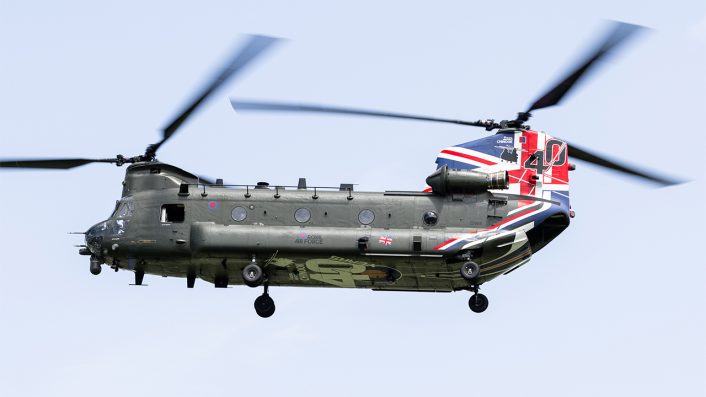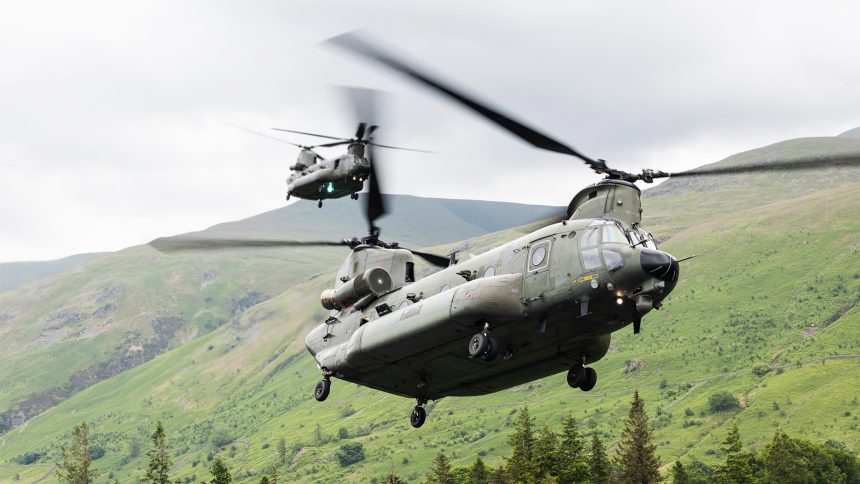A UK Government minister has confirmed that construction of the initial two new Chinook airframes has begun at Boeing’s Philadelphia facility.
Answering a written question submitted to the Secretary of State for Defence regarding the status of the outstanding Chinook order, department Minister of State Maria Eagle confirmed for the first time that Boeing has commenced production of the Royal Air Force’s new helicopters. She also confirmed that the delivery of the first aircraft is expected by 2027.
The decision to procure 14 new-build Chinook helicopters was confirmed in 2021, but finalisation of the order did not take place until 2024 after a number of delays and internal reviews. Choosing the extended range H-47ER variant, the new helicopters will feature larger fuel tanks like those on the RAF’s existing Chinook HC5 aircraft.
Some of the oldest Chinooks in the UK fleet, which entered service over forty years ago, have already been withdrawn as the Support Helicopter Force consolidates on a planned force of 51. This is a slight reduction from the 60 airframes previously in service, though it still constitutes one of the largest Chinook fleets worldwide.

Following the first expected deliveries in 2027, previous ministerial statements have set a prospective date of May 2029 for the declaration of initial operating capability (IOC). Full operating capability (FOC) would follow in October 2030. UK personnel will begin training as instructors on the new variant in August 2025.
Though little official comment has been made regarding the exact specification of the new helicopters, it has been understood by many aviation journalists that they will share a degree of similarity to the U.S. Army 160th Special Operations Aviation Regiment (SOAR)’s MH-47G Chinooks. Though the UK does not presently have the capability to refuel helicopters in the air, the helicopters will have the capability to do so. In December 2024, we reported that the Northrop Grumman Common Infrared Countermeasures (CIRCM) defensive system had been procured for the new Chinooks.
Although its not specified, we are essentially buying an MH-47G, like that used by the US Army’s 160th SOAR. That unit is the first customer for the Block II model. Our Block IIs will also have the Collins CAAS cockpit, not the Thales TopDeck currently on RAF Mk5/6/6A models. 2/3 pic.twitter.com/M62S2gVbOg
— Tony Osborne (@Rotorfocus) May 13, 2021
Fueling this speculation further, in 2024 two 160th SOAR Chinooks deployed to the UK to take part in Exercise Dark Lightning, aiming to improve interoperability between U.S. and UK Chinook units. As part of this exercise, the two helicopters visited RAF Odiham, home to the UK’s frontline Chinook forces, and conducted a low-level aerial refueling demonstration with an RAF Mildenhall based USAF MC-130J Commando II.
Three Chinook squadrons are based at RAF Odiham, including 7 Squadron which is the SHF’s contribution to the UK Joint Special Forces Aviation Wing (JSFAW). A number of Chinooks are additionally based at RAF Benson with 28 Squadron, the operational conversion unit (OCU).
The Chinook in RAF Service
Entering operational service in 1981, RAF Chinooks had a baptism of fire only months later in the Falklands War of 1982. Four Chinooks were loaded onto the requisitioned merchant vessel MV Atlantic Conveyor to be shipped into combat alongside the Harrier-equipped aircraft carrier task force.
When Atlantic Conveyor was attacked by Argentine aircraft using Exocet anti-ship missiles, three of these helicopters were lost in the inferno alongside a number of Wessex and Lynx. The sole surviving Chinook, serial ZA718, coded ‘BN’ or ‘Bravo November’, was airborne when the missiles struck and subsequently provided the task force’s only heavy lift capability throughout the war.
Photogs at @RAF_Cosford captured the moment Chinook ZA718, known by many as Bravo November made her final journey to the RAF Museum in Cosford
She is one of the original 30 aircraft ordered by the @RoyalAirForce in 1978 and was in service for 39 years pic.twitter.com/RujRMHBRxN
— RAF Photographer (@RAFPhotog) March 17, 2022
Serving until March 2022, Bravo November provided exemplary service in both Iraq and Afghanistan, taking a number of battle scars along the way. It is now preserved at the Royal Air Force Museum’s Midlands branch at RAF Cosford.
Much like the Army Air Corps’ AH-64 Apache attack helicopters, the UK’s force structure calls for the Chinooks to operate not just from land but also extensively from ships. Newer Royal Navy vessels are often specifically designed with flight decks of a size large enough to accommodate a Chinook, and the Queen Elizabeth class aircraft carriers’ aircraft lifts are able to transport a Chinook without removing its rotor blades. Chinooks can deploy with the carriers to provide a heavy lift logistics and carrier on-board delivery (COD) capability, as well as directly participate in amphibious combat operations.
This is a bit ‘tight’…shades of the Belvedere image I posted recently.
“An RAF Chinook in one of the elevators of HMS Queen Elizabeth. Although not part of the usual complement, the ship is certified to operate them and provide heavy lift capability to combined operations”. pic.twitter.com/gaCgoDSwKv
— Trev Clark’s Obscure Aviation History 🚁 (@clark_aviation) October 2, 2024
The aircraft’s heavy lift capability is also utilised under the Military Aid to Civil Authorities (MACA) system. Underslung loads of gravel, sand, and other aggregates can be airlifted to support flood relief operations, and even dropped directly into the path of the water. RAF Chinooks were also placed on alert early in the COVID-19 pandemic to provide logistics support and rapid patient transfer services to the National Health Service.









